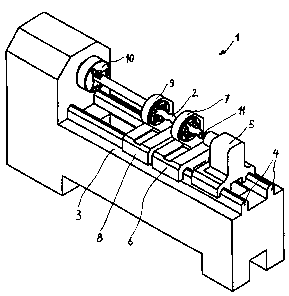Some of the information on this Web page has been provided by external sources. The Government of Canada is not responsible for the accuracy, reliability or currency of the information supplied by external sources. Users wishing to rely upon this information should consult directly with the source of the information. Content provided by external sources is not subject to official languages, privacy and accessibility requirements.
Any discrepancies in the text and image of the Claims and Abstract are due to differing posting times. Text of the Claims and Abstract are posted:
| (12) Patent Application: | (11) CA 2638236 |
|---|---|
| (54) English Title: | METHOD AND MACHINE FOR PRODUCING A ROTOR OF AN ECCENTRIC SCREW PUMP |
| (54) French Title: | METHODE ET MACHINE PERMETTANT LA PRODUCTION D'UN ROTOR D'UNE POMPE A VIS EXCENTRIQUE |
| Status: | Deemed Abandoned and Beyond the Period of Reinstatement - Pending Response to Notice of Disregarded Communication |
| (51) International Patent Classification (IPC): |
|
|---|---|
| (72) Inventors : |
|
| (73) Owners : |
|
| (71) Applicants : |
|
| (74) Agent: | SMART & BIGGAR LP |
| (74) Associate agent: | |
| (45) Issued: | |
| (22) Filed Date: | 2008-07-24 |
| (41) Open to Public Inspection: | 2010-01-24 |
| Examination requested: | 2011-07-18 |
| Availability of licence: | N/A |
| Dedicated to the Public: | N/A |
| (25) Language of filing: | English |
| Patent Cooperation Treaty (PCT): | No |
|---|
| (30) Application Priority Data: | None |
|---|
The present invention relates to a method and a machine for
producing a rotor of an eccentric screw pump, with which or in
which the shape of the rotor is produced by a peeling process
followed by a smoothing process of the surface. The object of the
invention is to make the smoothing process less time-consuming and,
in addition, more cost effective with this method or with this
machine. This object is solved with a method in which the
smoothing process is accomplished by smooth-rolling. The machine
for carrying out the method has a machine bed (3) on which a
peeling head (9) and a smoothing head (7) are arranged so as to be
axially movable for processing the rotor (2).
Note: Claims are shown in the official language in which they were submitted.
Note: Descriptions are shown in the official language in which they were submitted.

2024-08-01:As part of the Next Generation Patents (NGP) transition, the Canadian Patents Database (CPD) now contains a more detailed Event History, which replicates the Event Log of our new back-office solution.
Please note that "Inactive:" events refers to events no longer in use in our new back-office solution.
For a clearer understanding of the status of the application/patent presented on this page, the site Disclaimer , as well as the definitions for Patent , Event History , Maintenance Fee and Payment History should be consulted.
| Description | Date |
|---|---|
| Application Not Reinstated by Deadline | 2014-07-24 |
| Time Limit for Reversal Expired | 2014-07-24 |
| Inactive: Abandoned - No reply to s.30(2) Rules requisition | 2013-09-26 |
| Deemed Abandoned - Failure to Respond to Maintenance Fee Notice | 2013-07-24 |
| Inactive: S.30(2) Rules - Examiner requisition | 2013-03-26 |
| Letter Sent | 2011-08-03 |
| All Requirements for Examination Determined Compliant | 2011-07-18 |
| Request for Examination Requirements Determined Compliant | 2011-07-18 |
| Request for Examination Received | 2011-07-18 |
| Application Published (Open to Public Inspection) | 2010-01-24 |
| Inactive: Cover page published | 2010-01-24 |
| Inactive: IPC assigned | 2009-09-10 |
| Inactive: First IPC assigned | 2009-09-10 |
| Inactive: IPC assigned | 2009-09-10 |
| Correct Applicant Requirements Determined Compliant | 2009-08-26 |
| Inactive: Filing certificate - No RFE (English) | 2009-08-26 |
| Inactive: Applicant deleted | 2009-08-26 |
| Inactive: Correspondence - Formalities | 2009-07-15 |
| Inactive: Correspondence - Formalities | 2009-03-10 |
| Inactive: Filing certificate correction | 2008-11-07 |
| Inactive: Filing certificate - No RFE (English) | 2008-09-23 |
| Application Received - Regular National | 2008-09-23 |
| Abandonment Date | Reason | Reinstatement Date |
|---|---|---|
| 2013-07-24 |
The last payment was received on 2012-05-14
Note : If the full payment has not been received on or before the date indicated, a further fee may be required which may be one of the following
Patent fees are adjusted on the 1st of January every year. The amounts above are the current amounts if received by December 31 of the current year.
Please refer to the CIPO
Patent Fees
web page to see all current fee amounts.
| Fee Type | Anniversary Year | Due Date | Paid Date |
|---|---|---|---|
| Application fee - standard | 2008-07-24 | ||
| MF (application, 2nd anniv.) - standard | 02 | 2010-07-26 | 2010-07-15 |
| MF (application, 3rd anniv.) - standard | 03 | 2011-07-25 | 2011-07-15 |
| Request for examination - standard | 2011-07-18 | ||
| MF (application, 4th anniv.) - standard | 04 | 2012-07-24 | 2012-05-14 |
Note: Records showing the ownership history in alphabetical order.
| Current Owners on Record |
|---|
| ARTEMIS KAUTSCHUK- UND KUNSTSTOFF-TECHNIK GMBH |
| Past Owners on Record |
|---|
| SEBASTIAN JAEGER |
| WILLI WEINHOEFER |